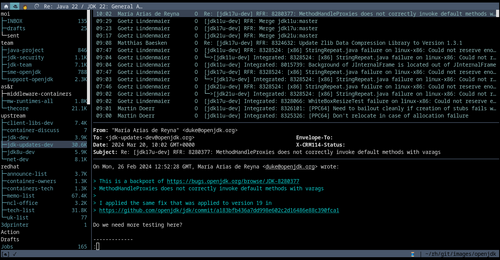jmtd → Jonathan Dowland's Weblog
Below are the five most recent posts in my weblog. You can also see a chronological list of all posts, dating back to 1999.
I haven't done that much crate digging recently, but I did stick this on last week: Trent Reznor's soundtrack for Quake, originally released (within the game) in 1996, and finally issued for the first time independently in 2020.
I picked it up the Nine Inch Nails gig in Cornwall, 2022.
An interesting factoid about the original release was the CD was mastered with the little-known pre-emphasis flag set to "on". This was relatively unusual at the time (1996) that it was never clear whether it was deliberate or not. CD ripping back then usually used an analog audio path from the CD-ROM drive to the PC sound card, and the CD-ROM would apply the necessary pre-emphasis. Therefore, ripping software didn't need to deal with it, and so most of it (then and now) doesn't, even though the path had long since changed to a purely-digital extraction. Thus, the various copies of the soundtrack circulating may or may not have had pre-emphasis correction applied, and if they did, it may or may not have been required to hear the soundtrack as it was intended.
I spent a bit of time a few years ago, before the reissue, trying to determine what was "correct". There is certainly an audible difference with pre-emphasis applied (or not), but it wasn't clear which was the intended experience. The reissue should have cleared this up once and for all, but I haven't gone back to check what the outcome was.
I've been enjoying Biosphere as the soundtrack to my recent "concentrated work" spells.
I remember seeing their name on playlists of yester-year: axioms, bluemars1, and (still a going concern) soma.fm's drone zone.
- Bluemars lives on, at echoes of bluemars↩
I recently became a maintainer of/committer to IkiWiki, the software that powers my site. I also took over maintenance of the Debian package. Last week I cut a new upstream point release, 3.20200202.4, and a corresponding Debian package upload, consisting only of a handful of low-hanging-fruit patches from other people, largely to exercise both processes.
I've been discussing IkiWiki's maintenance situation with some other users for a couple of years now. I've also weighed up the pros and cons of moving to a different static-site-generator (a term that describes what IkiWiki is, but was actually coined more recently). It turns out IkiWiki is exceptionally flexible and powerful: I estimate the cost of moving to something modern(er) and fashionable such as Jekyll, Hugo or Hakyll as unreasonably high, in part because they are surprisingly rigid and inflexible in some key places.
Like most mature software, IkiWiki has a bug backlog. Over the past couple of
weeks, as a sort-of "palate cleanser" around work pieces, I've tried to triage
one IkiWiki bug per day: either upstream or in
the Debian Bug
Tracker.
This is a really lightweight task: it can be as simple as "find a bug reported in
Debian, copy it upstream, tag it upstream, mark it forwarded; perhaps taking
5-10 minutes.
Often I'll stumble across something that has already been fixed but not recorded as such as I go.
Despite this minimal level of work, I'm quite satisfied with the cumulative progress. It's notable to me how much my perspective has shifted by becoming a maintainer: I'm considering everything through a different lens to that of being just one user.
Eventually I will put some time aside to scratch some of my own itches (html5 by
default; support dark mode; duckduckgo plugin; use the details tag...) but for
now this minimal exercise is of broader use.
I started looking at aerc, a new Terminal mail client, in around 2019. At that time it was promising, but ultimately not ready yet for me, so I put it away and went back to neomutt which I have been using (in one form or another) all century.
These days, I use neomutt as an IMAP client which is perhaps what it's worst
at: prior to that, and in common with most users (I think), I used it to read
local mail, either fetched via offlineimap or
directly on my mail server. I switched to using it as a (slow, blocking) IMAP
client because I got sick of maintaining offlineimap (or
mbsync), and I started to use neomutt to
read my work mail, which was too large (and rate limited) for local
syncing.
This year I noticed that aerc had a new maintainer who was presenting about
it at FOSDEM, so I thought I'd take another look. It's
come a long way: far enough to actually displace neomutt for my day-to-day
mail use. In particular, it's a much better IMAP client.
I still reach for neomutt for some tasks, but I'm now using aerc for most
things.
aerc is available in Debian, but I recommending building from upstream source
at the moment as the project is quite fast-moving.
How can I not have done one of these for Propaganda already?
Propaganda/A Secret Wish is criminally underrated. There seem to be a zillion variants of each track, which keeps completionists busy. Of the variants of Jewel/Duel/etc., I'm fond of the 03:10, almost instrumental mix of Jewel; preferring the lyrics to be exclusive to the more radio friendly Duel (04:42); I don't need them conflating (Jewel 06:21); but there are further depths I've yet to explore (Do Well cassette mix, the 20:07 The First Cut / Duel / Jewel (Cut Rough)/ Wonder / Bejewelled mega-mix...)
I recently watched The Fall of the House of Usher which I think has Poe lodged in my brain, which is how this album popped back into my conciousness this morning, with the opening lines of Dream within a Dream.
But are they Goth?
Older posts are available on the all posts page.


